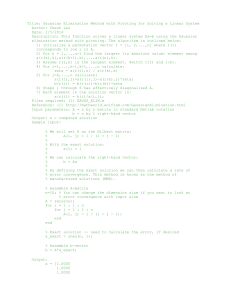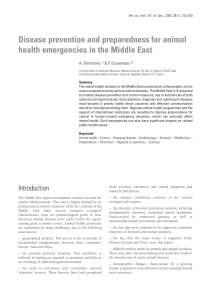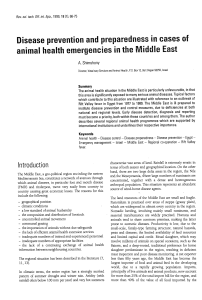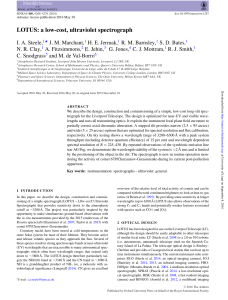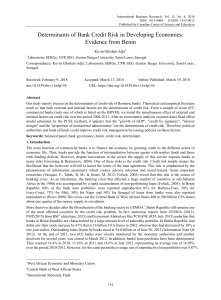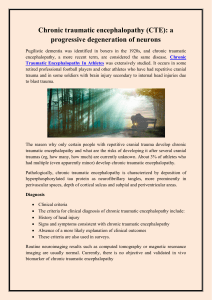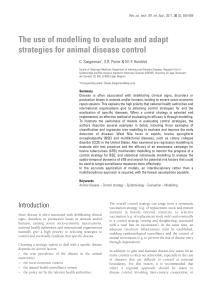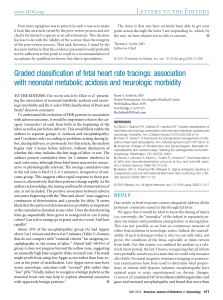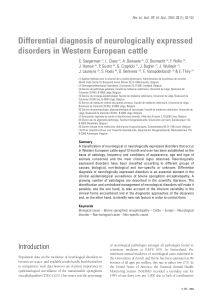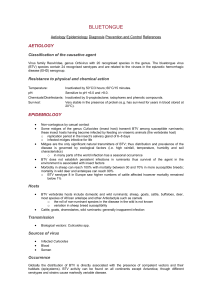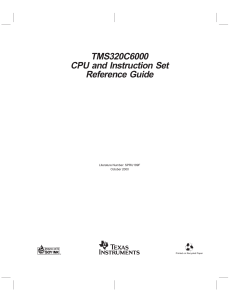D8647.PDF
publicité
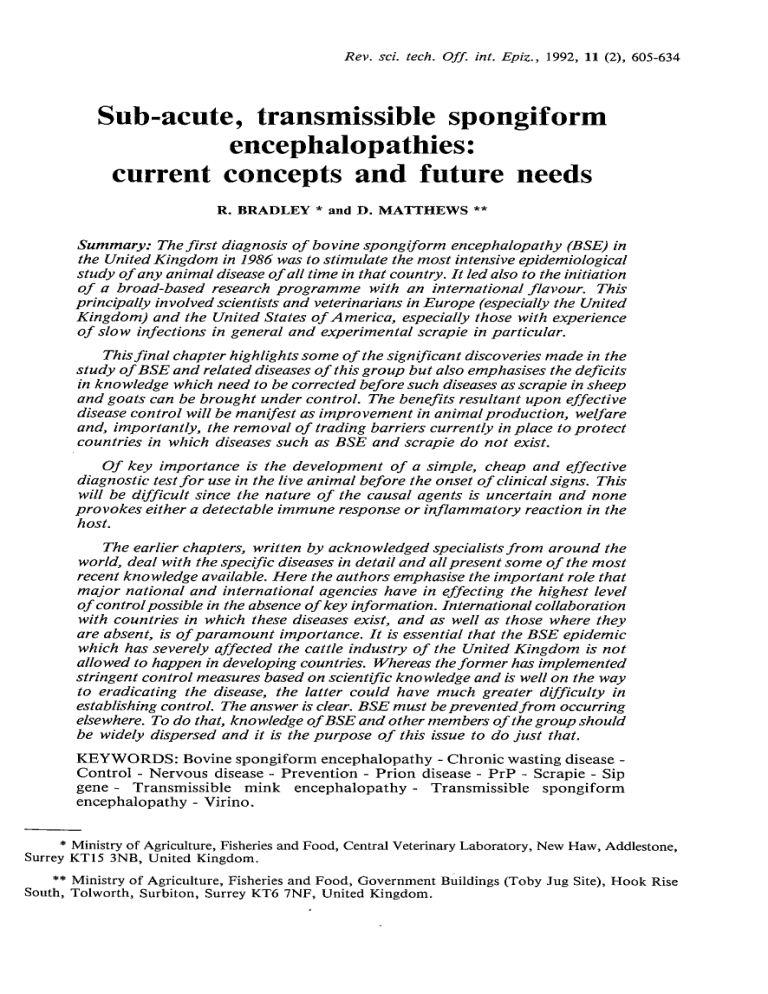
Rev. sci. tech. Off. int. Epiz., 1992, 11 (2), 605-634 Sub-acute, transmissible spongiform encephalopathies: current concepts and future needs R. BRADLEY * and D. MATTHEWS ** Summary: The first diagnosis of bovine spongiform encephalopathy (BSE) in the United Kingdom in 1986 was to stimulate the most intensive epidemiological study of any animal disease of all time in that country. It led also to the initiation of a broad-based research programme with an international flavour. This principally involved scientists and veterinarians in Europe (especially the United Kingdom) and the United States of America, especially those with experience of slow infections in general and experimental scrapie in particular. This final chapter highlights some of the significant discoveries made in the study of BSE and related diseases of this group but also emphasises the deficits in knowledge which need to be corrected before such diseases as scrapie in sheep and goats can be brought under control. The benefits resultant upon effective disease control will be manifest as improvement in animal production, welfare and, importantly, the removal of trading barriers currently in place to protect countries in which diseases such as BSE and scrapie do not exist. Of key importance is the development of a simple, cheap and effective diagnostic test for use in the live animal before the onset of clinical signs. This will be difficult since the nature of the causal agents is uncertain and none provokes either a detectable immune response or inflammatory reaction in the host. The earlier chapters, written by acknowledged specialists from around the world, deal with the specific diseases in detail and all present some of the most recent knowledge available. Here the authors emphasise the important role that major national and international agencies have in effecting the highest level of control possible in the absence of key information. International collaboration with countries in which these diseases exist, and as well as those where they are absent, is of paramount importance. It is essential that the BSE epidemic which has severely affected the cattle industry of the United Kingdom is not allowed to happen in developing countries. Whereas the former has implemented stringent control measures based on scientific knowledge and is well on the way to eradicating the disease, the latter could have much greater difficulty in establishing control. The answer is clear. BSE must be prevented from occurring elsewhere. To do that, knowledge of BSE and other members of the group should be widely dispersed and it is the purpose of this issue to do just that. KEYWORDS: Bovine spongiform encephalopathy - Chronic wasting disease Control - Nervous disease - Prevention - Prion disease - PrP - Scrapie - Sip gene - Transmissible mink encephalopathy - Transmissible spongiform encephalopathy - Virino. * Ministry of Agriculture, Fisheries and Food, Central Veterinary Laboratory, New Haw, Addlestone, Surrey KT15 3NB, United Kingdom. ** Ministry of Agriculture, Fisheries and Food, Government Buildings (Toby Jug Site), Hook Rise South, Tolworth, Surbiton, Surrey KT6 7NF, United Kingdom. 606 CONTENTS INTRODUCTION 607 CONTRASTS BETWEEN ANIMAL AND HUMAN TRANSMISSIBLE SPONGIFORM ENCEPHALOPATHIES 607 CURRENT DATA ON CONFIRMED INCIDENTS OF SPONGIFORM ENCEPHALOPATHY IN ANIMALS Cattle - bovine spongiform encephalopathy Sheep, goats and moufflon - scrapie Cats — feline spongiform encephalopathy Exotic Bovidae - spongiform encephalopathy Deer - chronic wasting disease Pigs, chickens and other domesticated livestock reared for food Mink - transmissible mink encephalopathy Ostriches - spongiform encephalopathy 609 609 609 616 617 617 617 617 617 CERTIFICATION AND TRADE 618 RESULTS OF RESEARCH STUDIES ON TRANSMISSION FROM TISSUES OF BSE-AFFECTED CATTLE Host range studies Tissue transmission studies 619 619 619 BSE IN ANIMALS BORN AFTER THE INTRODUCTION OF THE RUMINANT FEED BAN IN JULY 1988 621 OTHER ENIGMAS 621 METHODS AND CRITERIA FOR BSE DIAGNOSIS 621 CONCLUDING REMARKS 622 ACKNOWLEDGEMENTS Appendix 1 PROTOCOLS FOR THE DIAGNOSIS OF BOVINE SPONGIFORM ENCEPHALOPATHY IN THE UNITED KINGDOM Introduction Removal of the brain for histological examination Fixation THE FORAMEN MAGNUM TECHNIQUE Procedure HISTOLOGICAL PROCESSING PROCEDURES FOR BRAIN TISSUE OF SUSPECT BSE CASES A. Extended processing schedule for large and thicker blocks than standard in an enclosed tissue processor B. Routine overnight processing schedule using a "Shandon Hypercentre" enclosed tissue processor C. Processing schedule for a carousel-type tissue processor STAINING: HAEMATOXYLIN AND EOSIN SCHEDULE DIAGNOSTIC CRITERIA USED IN THE UNITED KINGDOM 623 REFERENCES 625 625 626 626 627 627 630 630 630 631 631 632 632 607 INTRODUCTION For the 60th General Session of the OIE in May 1992, bovine spongiform encephalopathy (BSE) was selected as a major topic, particularly in view of the discussion on the International Animal Health Code Chapter on BSE. The Code Chapter is designed to provide additional information to facilitate trade in cattle and cattle products whilst minimising risk to importing countries. Preceding papers in this Review deal with the specific "naturally-occurring" transmissible spongiform encephalopathies of animals. They consider the agents which cause them, and the factors controlling the occurrence of disease in an exemplary way, bringing together in a single journal much scientific information that is otherwise widely dispersed in scientific literature. The purpose of this paper is to link these presentations, to contrast the animal diseases with their human counterparts, and to provide the most up-to-date field and research data, particularly with respect to BSE and the most recently discovered spongiform encephalopathies (SE) in other species. It also highlights deficits in knowledge which currently restrain governments, breed societies and farmers from implementing control measures (particularly in regard to scrapie) which are costly, usually draconian, and uncertain in outcome. CONTRASTS BETWEEN ANIMAL AND HUMAN TRANSMISSIBLE SPONGIFORM E N C E P H A L O P A T H I E S The three human TSEs, Creutzfeldt-Jakob disease (CJD), Gerstmann-Sträussler (Scheinker) syndrome (GSS) and kuru are rare and have only been recognised and defined in the twentieth century. On the other hand, scrapie of sheep has been known and lucidly recorded in European literature since at least the early 1700s (13). All the other transmissible spongiform encephalopathies (TSEs) of animals have only been recognised since 1950. Although all these diseases, human and animal, are infectious and have been transmitted experimentally, only scrapie of sheep (and perhaps goats and moufflon) is naturally contagious. Even in sheep, the only certain vehicle of contagion is the placenta and even that has been proven only from Swaledale sheep (17). Maternal transmission seems to be important in sheep scrapie, which is the reason why the disease is endemic and difficult to eradicate, but it does not occur, or is at least unproven, in all the other diseases. Clearly in sheep, probably in goats and moufflon, and perhaps in all ruminants, it is important to reduce risks of transmission between animals by isolating animals at the time of parturition. Controlled destruction of placenta and foetal fluids, and cleaning and disinfection of the premises used for parturition are also appropriate before use by other animals. Only in sheep has it been shown that offspring from affected dams are likely to be infected, thus necessitating the removal of family lines if disease is to be controlled. It is, however, not inevitable that maternal transmission will occur in all offspring of affected dams. At least one gene of sheep (Sip), and 608 perhaps others, influence the length of incubation, neuroinvasion and occurrence of clinical disease. Consequently, identification of resistant animals may become an increasingly important feature of control. The human disease, CJD, exists in three forms - familial (less than 15% of total cases) (14), sporadic (greater than 85%), and iatrogenic (extremely rare). GSS is also a familial disease and, like familial CJD, is associated with the occurrence of mutations in the PrP gene, both of which are hereditary. No such counterpart has been shown to occur naturally in animals but, if present, would appear to be at such a low incidence as to be undetectable. However, since such occurrence would probably result only from mutation, no country can be complacent that no animal SE (including BSE or scrapie) could ever occur in indigenous animals. Risks from such a development would be very small, but not absent. The development of transgenic rodents with mutant PrP genes responsible for hereditary TSEs in humans is likely to be a very valuable research tool for further studies. The familial human spongiform encephalopathies are also transmissible, as are cases of the sporadic and iatrogenic forms of. CJD (Ridley, personal communication). Iatrogenic transmission of CJD is rare, but has resulted from the use of biological medicinal products (cornea, dura mater, human pituitary-derived growth hormone, human gonadotrophin) or insufficiently decontaminated neurosurgical instruments and depth EEG electrodes (22). In animals, the most notable report of iatrogenic disease involved over 300 cases of scrapie caused by the use of a formalised louping ill vaccine prepared from sheep brains (11). Iatrogenic transmissions demonstrate the need for safe sourcing of biological products since scrapie-like agents are extremely resistant to procedures that are totally effective in destroying conventional micro-organisms. While the origin of the majority of CJD cases (sporadic CJD) is unknown, some suggest somatic mutation in the PrP gene to be the cause. In common with iatrogenic CJD however, sporadic CJD does not appear to be associated with diseases of animals, contact with animals, or use, or consumption of animal products. In other words, the animal diseases are not zoonoses as determined by all the evidence accrued from extensive epidemiological studies of the human diseases (4, 5, 6, 14, 22, 23). The advent of BSE in 1986 rekindled quiescent thoughts on the risks to humans from the animal diseases and BSE in particular. The United Kingdom Department of Health has therefore funded a national surveillance programme for CJD commencing in May 1990, to identify any change in the pattern of CJD. This complements earlier studies by Professor W.B. Matthews (23) in England and Wales between 1970 and 1984. A retrospective survey to cover the period 1985 to 1990 is also in progress. Although the study has not yet been completed, the number of certified cases of CJD does not appear to have increased between 1980 and 1990. Parallel studies are being planned in other European countries, including the Netherlands and France, under the auspices of the Public Health Section of the European Community (EC) Scientific Veterinary Committee. The conclusion from all these studies is that as Professor Sir Richard Southwood reported the risk to man from BSE is remote (8). 609 C U R R E N T D A T A ON C O N F I R M E D I N C I D E N T S OF SPONGIFORM E N C E P H A L O P A T H Y IN ANIMALS Cattle - bovine spongiform encephalopathy The first case of BSE was confirmed in November 1986 in England. Retrospective analysis of clinical histories has however suggested that the earliest case occurred around April 1985. Readers are reminded that Figure 1 of the paper by Kimberlin (page 354) includes such "early cases" where histopathological confirmation did not take place. Lesions of spongiform encephalopathy have been demonstrated by brain histopathology in most confirmed cases of BSE. For small numbers of animals where autolysis has precluded such examination, diagnosis has relied on identification of scrapie-associated fibrils (SAF) in extracts of central nervous tissue. On 16 April 1992, 53,595 cases of BSE had been confirmed on 17,401 British farms. The youngest case was 22 months old and the oldest 17 years. The confirmed dairy herd incidence was 33%, the confirmed beef suckler herd incidence 4.7%, and the confirmed total herd incidence 18.2%. In other words, almost 82% of cattle herds in Great Britain had not experienced BSE. BSE has been confirmed in several other countries listed by Kimberlin is this issue (12). With a constantly moving picture, readers are referred to individual State Veterinary Authorities for accurate statistics on their confirmed cases. Sheep, goats and moufflon — scrapie Presentation of current data on the prevalence and incidence of scrapie in various species in different countries is extraordinarily difficult. This is because the disease is only notifiable in some countries, generally those in which the disease is absent or has been eradicated. Member Countries of the OIE report their scrapie status annually, and Table I summarises returns to April 1992 for the years 1980, 1985, 1990 and 1991. Table II summarises those countries in which scrapie has never been recorded, or the date of the last confirmed case. In other words, this lists countries which currently claim freedom from the disease. As indicated in the paper by L.A. Detwiler (9), such statements need careful interpretation. They rely on the awareness of animal keepers of the clinical signs of scrapie and the importance of reporting them, as well as on the surveillance procedures in place to detect and confirm disease. This includes histopathological, electron microscopical (for SAF detection), and immunoblotting procedures to detect PfpSc Furthermore, it is also necessary to have strict control of importation, compulsory notification, and a planned stamping-out policy should disease ever be detected. The OIE publication Animal Health in the Eighties (15), summarises scrapie control procedures in place in certain Member Countries, namely: compulsory notification, stamping-out, modified stamping-out and prohibition of imports from infected countries. These are reproduced in Table III. 610 TABLE I Summary Countries Afghanistan of the scrapie status in countries reported to the OIE (1980, 1985, 1990 and 1991) 1980 1985 - - Albania Algeria - - Angola - 0000 which 1990 1991 0000 Antigua and Barbuda - - - Argentina - 0000 0000 0000 Australia - - (1952) (1952) Austria - - - - Bahamas - 0000 0000 - + Bahrain Bangladesh Barbados (-) - 0000 Belgium (-) - 0000 - - 0000 - - Bolivia (-) 0000 0000 0000 0000 Botswana 0000 0000 0000 0000 Brazil - +<= - (1985) Bulgaria - 0000 0000 Burkina Faso - - - Belize Benin Bhutan 0000 Burundi - Cameroon Canada - 0000 - (+) + (+) Cambodia - - - Central African Republic - ? - 0000 0000 0000 (-) - (1976) (1976) (-) - - - (+) Cape Verde Chad Chile C h i n a (People's Rep. of) Colombia Congo 611 TABLE I (contd) Summary of the scrapie status in countries reported to the OIE (1980, 1985, 1990 and 1991) which Countries 1980 1985 1990 Costa Rica - 0000 0000 Cote d'Ivoire 1991 - - Cuba - - 0000 0000 Cyprus - +() - +! - +() Czech and Slovak Fed. Rep. - 0000 0000 0000 (+) 0000 - 0000 Dominican Rep. 0000 0000 0000 Ecuador 0000 0000 0000 0000 Egypt El Salvador - 0000 0000 0000 - 0000 0000 0000 Ethiopia - 0000 0000 Falkland Islands - - - Finland - 0000 0000 0000 France +() + + + - - - 0000 0000 Denmark Djibouti Gabon Germany Ghana - 0000 0000 0000 Greece 0000 0000 0000 0000 Guatemala 0000 0000 0000 Guinea - - Haiti - - Honduras - - - 0000 0000 0000 0000 (-) 0000 0000 0000 +() India ? 0000 (+) 0000 0000 Indonesia - - Iran - 0000 Iraq - Ireland + Hong K o n g Hungary Iceland +() 0000 0000 + + + 612 TABLE I (contd) Summary of the scrapie status in countries reported to the OIE (1980, 1985, 1990 and 1991) which Countries 1980 1985 1990 1991 Israel 0000 0000 0000 0000 Italy Japan (+) - + + + Jordan - Kenya - 0000 K o r e a (Rep. of) - - 0000 0000 Kuwait - - - - Laos Lebanon (+) 0000 - - 0000 0000 Libya - - 0000 Luxemburg - 0000 0000 Madagascar - 0000 0000 Malawi - 0000 0000 Malaysia (peninsular) - 0000 0000 Malaysia (Sabah) - - - Malaysia (Sarawak) - - - Mali - - Malta - - - - Mauritania - 0000 - - Mauritius - - 0000 Mexico - 0000 0000 Morocco - 0000 0000 0000 Mozambique - - - - Myanmar + - Namibia 0000 0000 0000 0000 - - (+) + + ? ? (-) (1954) 0000 0000 0000 (1954) (1954) (1954) Lesotho Mongolia Nepal Netherlands N e w Caledonia New Zealand - 0000 0000 - 0000 0000 0000 613 TABLE I (contd) Summary Countries of the scrapie status in countries reported to the OIE (1980, 1985, 1990 and 1991) 1980 Niger Nigeria Norway (1956) Oman which 1985 1990 0000 0000 0000 0000 0000 (+) + - 0000 0000 Pakistan - Panama - 0000 0000 0000 Paraguay Peru Philippines 0000 - 0000 0000 0000 - - 0000 Poland - 0000 0000 Portugal - - 0000 Romania - 0000 0000 Saint Lucia - - Saudi Arabia - Senegal - + Seychelles - - - Sierra L e o n e - 0000 Singapore South Africa Spain Sri L a n k a 0000 0000 - 0000 - - - (1972) (1972) (1972) 0000 0000 - - - 0000 0000 - - 0000 (1986) (1986) Sudan Swaziland 0000 0000 Saint Kitts and Nevis Somalia 1991 (1972) 0000 - - 0000 Switzerland - ? - (+) Syria ? 0000 0000 - 0000 0000 0000 0000 0000 Sweden T a i w a n R.O.C. Tanzania - - Thailand - 0000 614 TABLE I (contd) Summary of the scrapie status in countries reported to the OIE (1980, 1985, 1990 and 1991) Countries which 1980 1985 1990 (-) - 0000 - - 0000 - - - Turkey - + - Uganda ? - 0000 United A r a b Emirates - 0000 Togo Trinidad a n d T o b a g o Tunisia United K i n g d o m (G.B.) 1991 - 0000 0000 + + + + (1972) (1972) + + (+) + (+) + Uruguay 0000 0000 0000 0000 USSR 0000 0000 0000 United K i n g d o m ( N . Ireland) United States of A m e r i c a Vanuatu - 0000 0000 0000 Venezuela - - - - Vietnam - - Virgin Islands 0000 0000 Yugoslavia - Zaire - + 0000 0000 0000 0000 - 0000 0000 0000 Zambia Zimbabwe CODE Disease occurrence 0000 Never reported - Not reported (-) Not recorded; probably not present (Year) Year of last occurrence ? Suspected but not confirmed ( + ) Exceptional occurrence + Disease present () Confined to certain regions ! Recognised in country for the first time Only in imported animals (quarantine) ... No information available + 615 TABLE II Countries which claim freedom from scrapie (reports received in 1990 and 1991) Countries reporting freedom from scrapie Albania Argentina Australia: 1952 Bahamas Barbados Belize Benin Bolivia Botswana Brazil: 1985 Bulgaria Burundi Chile Colombia: 1976 Costa Rica Cuba Denmark Dominican Republic Ecuador Egypt El Salvador Ethiopia Finland Germany Ghana Greece Guatemala Honduras Hong Kong Hungary India Iran Iraq Israel Korea (Rep. of) Lesotho Libya Luxembourg Madagascar Malawi Malaysia (Peninsular) Mauritius Mexico Mongolia Morocco Myanmar Namibia New Caledonia New Zealand: 1954 Niger Nigeria Oman Pakistan Panama Paraguay Philippines Poland Portugal Romania St Kitts and Nevis Singapore South Africa: 1972 Sri Lanka Sudan Sweden: 1986 Syria Taiwan R.O.C. Thailand Trinidad and Tobago Uganda United Arab Emirates Uruguay USSR Vanuatu Vietnam Virgin Islands Zambia Zimbabwe Year: date of the last confirmation of disease Source: OIE World Animal Health, Vol. VI, 1990 and Reports received for publication in World Animal Health, Vol. VII, 1991 616 TABLE III Summary of policies of certain countries in regard to scrapie control Control policy Countries CN Argentina Australia Botswana Brazil Cuba Cyprus Denmark Ecuador El Salvador Finland Germany Israel Korea (Rep. of) Mexico New Caledonia New Zealand Norway Philippines Romania South Africa Sweden Trinidad and Tobago Turkey USA USSR Vanuatu Venezuela SOP MSOP POI + + + + + + + + + + + + + + + + + + + + + + + + + + + + + + + + + + + + + + + + CN = compulsory notification SOP = stamping-out policy MSOP = modified stamping-out policy POI = prohibition on imports from infected countries Source: Animal Health in the Eighties (15) Cats — feline spongiform encephalopathy The first case of feline spongiform encephalopathy (FSE) in a domestic cat was recognised in April 1990 (26). To date, 26 cases have been confirmed, one of which was in Northern Ireland and another on the island of Guernsey. The source of infection is unknown but is presumed to be food. Cat to cat transmission has not been reported, but, experimentally, the disease has been transmitted to mice by parenteral inoculation of cat brain tissue. Transmission was successful with both unfixed brain and tissue previously fixed in formalin. Spongiform encephalopathy has recently been diagnosed in other carnivores (captive cheetah and puma) (16, 25). 617 Exotic Bovidae - spongiform encephalopathy A total of 10 cases have been identififed in five species of exotic Bovidae captive in British zoos or wildlife parks. These species are nyala (Tragelaphus angasi: 1 case), gemsbok (Oryx gazella: 1 case), Arabian oryx (Oryx leucoryx: 1 case), greater kudu (Tragelaphus strepsiceros: 3 cases) and eland (Taurotragus oryx: 4 cases). One of the kudu was the offspring of a confirmed case and may have been the consequence of maternal transmission. Transmission to mice from fixed brain tissue of the nyala and kudu has been successful, confirming that disease in these individuals is a TSE. Apart from the kudu offspring case, most of the other individuals had access to food or pasture potentially contaminated with infected offals or protein derived from them. It is important to note the close relationship between these exotic ruminants and cattle, sheep and goats, which all fall within the family Bovidae. They are however quite distinct from deer, which belong to the family Cervidae. Deer - chronic wasting disease Chronic wasting disease (CWD) is confined to mule deer (Odocoileus hemionus hemionus), black-tailed deer (O. hemionus columbianus), mule deer crossed with white-tailed deer (O. virginianus) and Rocky Mountain elk (Cervus elaphus nelsoni) in Colorado and Wyoming in the United States of America (24). No such disease has been identified anywhere else in the world, with the exception of one case in a Canadian zoo. Concern has been expressed about another disease of deer, "Chronic ill thrift", which occurs in New Zealand, but this has no connection either aetiologically or pathologically with CWD in particular or SEs in general. There is no specific cause, but a scrapie-like disease can be definitely excluded as a result of rigorous investigations carried out by the New Zealand veterinary authorities. Pigs, chickens and other domesticated livestock reared for food No naturally-occurring spongiform encephalopathy has been identified in these species anywhere in the world. In the United Kingdom, and some other countries, veterinary surveillance schemes in operation are extensive and any significant incidence of a progressive neurological disease would be detected by clinical examination supported by histopathological examination of brains. Mink — transmissible mink encephalopathy Transmissible mink encephalopathy (TME) has never been diagnosed in mink in the United Kingdom or indeed any countries in which BSE has been confirmed. Ostriches - spongiform encephalopathy Ostriches kept in German zoos showed lesions of spongiform encephalopathy (18, 19), but transmissibility and the presence of SAF and abnormal PrP have still to be demonstrated. Therefore, doubt still prevails in regard to the cause of this disease. 618 CERTIFICATION AND TRADE The appearance of BSE has emphasised the need for rigorous certification of imported animals and some animal products in species affected by spongiform encephalopathies. Since there is no practical effective test to detect the presence of disease in the live animal, all certification must be circumspect and carry an element of risk. Nevertheless, it is possible to reduce this risk to a minimum, as detailed in the chapters in this Review on BSE and scrapie (9, 12). Clearly, with different routes of transmission, BSE and scrapie require the application of different strategies for control and certification. In BSE, where the only significant route of infection is considered to be via feed, it is relatively simple to certify country and animal freedom at an appropriate time, particularly if a food source is eliminated, and if assurances can be given that animals for export are not the offspring of affected cases. Provided that appropriate mandatory controls, such as a ban on feeding ruminant protein to ruminant animals, are in place and adhered to, the risk factors are minimal, even from countries with significant numbers of confirmed cases. With scrapie, a different strategy must be adopted, and applied, at the flock level. This is because it is a flock disease, unlike BSE, with both maternal and horizontal transmission playing a role in perpetuating disease. Furthermore, the Sip gene exerts an important control over disease occurrence and may mask the presence of infection. Thus it is only possible to certify disease freedom when all animals are clearly and permanently identified, breeding records are meticulous, audited by a competent authority, and thorough pathological investigation of neurological disease is implemented. To satisfy definition of country freedom from scrapie would mean that every flock within the country would have to satisfy the criteria specified. Since the majority are entirely commercial non-pedigree flocks, this is an unnecessary burden for countries and individual farmers to carry. It is however important that flocks within countries which export breeding stock abide by strict rules in order to reduce the risk of scrapie transmission to an acceptable minimum. In the EC, scrapie must become a notifiable disease by 1 January 1993. The Community is currently considering how such certification can be implemented in order to foster internal trade in live animals for breeding whilst strictly controlling the risk of transmitting disease. This will be done by adopting rules on a flock basis similar to those in place in the United Kingdom Sheep and Goat Health Scheme scrapie option (9). Inevitably, the validity of certification of freedom from disease will always be enhanced the longer freedom can be maintained. With a modal incubation period for natural scrapie of about three and a half years, freedom for less than this period is meaningless. Five years' freedom might give a small degree of assurance, but while confidence does progressively increase with time, absolute guarantees may prove impossible given the genetic influences on disease expression. Governments and individuals should therefore be aware of the risks of introducing disease, and of ways of reducing them to acceptable levels, whilst also permitting genetic improvements through the importation of animals, semen and embryos of superior genetic merit. Embryo transfer is, as yet, not proven to be a completely safe procedure in eliminating scrapie, but this subject will be discussed further below. 619 A major problem remains how to enable countries now generally regarded as free from scrapie to become integrated without penalty into a new international trading scheme. This may become the subject for future discussion, but the lack of accurate data on disease incidence world-wide means that assessment of risk before trading commences may be difficult. R E S U L T S O F R E S E A R C H S T U D I E S ON T R A N S M I S S I O N F R O M TISSUES O F B S E - A F F E C T E D C A T T L E Host range studies BSE has been successfully transmitted directly to scrapie-susceptible strains of mice (now an experimental model system), cattle, sheep, goats, pigs and marmosets, but not to hamsters (this required prior sub-passage via mice). The diseases and the neuropathology so produced in cattle, sheep and goats are broadly similar to the natural diseases of those species. The results of attempted transmission to mink are pending. The transmission to sheep, goats and mice is not unexpected, that to pigs of little consequence, other than to stimulate the extension in the United Kingdom of the prohibition on the use of specified bovine offals for food to all species. The transmission to marmosets may concern some, but it should be recalled that scrapie was transmitted many years ago to primates (but not to chimpanzees). The minimum incubation period in marmosets inoculated with scrapie was, at 38 months, substantially greater than that in experiments involving CJD (less than 22 months). BSE took even longer (48 months). These differences may however merely reflect agent titre in the inoculum. It would appear that the species barrier between cattle and marmosets is nevertheless substantial, although not absolute. It should be remembered that the experiment was initiated before successful transmission to mice was achieved, and might have provided very valuable information had transmission occurred more rapidly and had no transmission occurred in the other experimentally-challenged species. Now the result is more of comparative historical interest, but serves to show that transmission risks are measurable and steps need to be taken (and have been) to protect wild and other species from exposure to the BSE agent. Tissue transmission studies A wide range of tissues from BSE-affected cattle have been inoculated parenterally into susceptible mice. So far, transmission has only succeeded with brain tissue. Some experiments have been in progress more that 700 days from inoculation, which is beyond the accepted scientific end-point for a negative transmission of SEs. The mice remain clinically healthy. The tissues involved (days post-inoculation are given in parentheses) are, at 23 April 1992, spleen (994); semen (967); buffy coat of blood (904); muscle [M. diaphragma] (896); muscle [M. semitendinosus] (899); placenta (811); and bone marrow (780). Oral challenge studies of mice with various tissues are now complete, and only brain/cerebrospinal fluid resulted in transmission. There was no detectable infectivity after massive challenge with spleen, mesenteric and carcass lymph nodes, 620 suprammamary lymph nodes, udder/milk, or placenta (1, 2) even after now completed blind parenteral passage of spleen and spinal cord at 12 and 18 months post-inoculation (Barlow, personal communication). These studies collectively show that there is no detectable infectivity in the listed tissues, as revealed by the assay system used. Thus BSE differs significantly from scrapie with respect to tissue distribution of agent. Of particular importance is the absence of detectable infectivity in semen or placenta, the former in line with findings for scrapie using a mouse model. Oronasal exposure of cattle to placenta is in progress (challenged at the end of 1989), but no clinical disease has resulted to date. Offspring and embryo transfer studies in cattle are also in progress. In the former, over 300 pairs of cattle (pairs means an offspring of a confirmed case plus a control from the same farm with a live, aged dam) are being held on Ministry of Agriculture farms for observation (without mating). The embryo transfer study involves transfer of embryos from field cases of BSE, mated by artificial insemination to either healthy or BSE-affected bulls. Embryos are transferred according to the International Embryo Transfer Society protocols, and recipients, imported from New Zealand, are kept in quarantine on a Ministry of Agriculture farm. To date, over 100 of a total of 350 eventual recipients have confirmed pregnancies. The first few calves have been born. Offspring and recipients will be observed until they are seven years of age before slaughter and examination of brains for spongiform encephalopathy. Any that die during the course of the experiment will of course be subjected to the same examination. The initial results have now been published of an experiment which forms part of a series of studies involving embryo transfer from sheep inoculated experimentally with scrapie (10). In contrast to the studies in cattle, donor and recipient Cheviot sheep were selected by their Sip genotype, determined by restriction fragment length polymorphism (RFLP) analysis of the PrP gene. Donor ewes were inseminated with semen from a healthy unexposed ram, and embryos were transferred without washing in order to enhance the possibility of transmission. Recipients (Sip pApA but including one sApA) were not susceptible to natural scrapie. Offspring were of three genotypes (sAsA, sApA, pApA). Six Sip sAsA sheep developed scrapie at approximately two years of age, but the others (11 sApA and 3 pApA) were still alive at the time of publication. This experiment demonstrates that the embryo, under the conditions of the experiment, may transmit infection, but whether on the surface of the zona pellucida or within the substance of the embryo is unknown. This is the subject of further studies. This experiment does not call into question the safety of bovine embryos with respect to transmission of BSE, but guidelines to prevent transmission, either of scrapie or BSE via embryos, have been proposed within EC and OIE Working Groups. Briefly, in regard to scrapie, it is recommended that movement of embryos or semen should be restricted to that between flocks of equivalent scrapie status, or from higher to lower status flocks. In regard to BSE, there are no proposals for restrictions on the use of semen, but embryos should not be derived from animals that have consumed ruminant protein, have been affected with BSE or from their daughters. 621 BSE IN ANIMALS BORN AFTER THE INTRODUCTION O F T H E R U M I N A N T F E E D B A N I N J U L Y 1988 There have been some 38 cases confirmed in such animals so far. While to the casual observer this might suggest an origin of infection other than food, nothing could be further from the truth. Only in one instance does it appear that maternal transmission is likely. The dam of this case was BSE-positive, and a food source was effectively eliminated. While some investigations are still in progress, it is considered that most of these cases were at some risk of exposure via food, largely through carry over of stocks manufactured before the feed ban, or due to accidental inclusion of meat-and-bone meal. It should be stressed however that the confirmed cases in this age group are far fewer than expected if there had been no ruminant feed ban. In other words, while the cut-off point for cessation of feeding of ruminant protein was not as precise as intended, it has had an effect on disease incidence (21). For example, the incidence in two-year-old cattle (over two but less than three years of age) was lower in 1991 (0.01 %) than in 1990 (0.05%). Further analyses in progress support this encouraging picture. With each passing calving year, the ban should progressively reduce the incidence in older age groups, eventually significantly affecting the overall report rate four to five years after the introduction of the feeding ban (the modal incubation period being four and a half years) - in effect, through the winter calving season of 1992-1993. Nevertheless, while such data are encouraging, because only relatively small numbers of affected cattle at the younger end of the age range are currently involved, the authors caution against drawing firm conclusions at this stage. OTHER ENIGMAS At every turn, research into this group of diseases produces unexpected findings. The nature and molecular biology of the agents admirably described in the chapter by Bennett and colleagues is a case in point (3). At the more practical level, a short letter to the Veterinary Record by Clark (7), a veterinary investigation officer with wide experience of scrapie, describes a study involving 192 submissions, where 15% of suspect cases of scrapie exhibiting classical signs of pruritus, emaciation, ataxia and hyperaesthesia gave negative diagnoses on histopathological examination of brain tissue. In the same study, 2 1 % of sheep found dead for no obvious reason were histopathologically positive for scrapie. Clearly such observations are important and should be accommodated when drafting protocols for scrapie control or certification. METHODS A N D CRITERIA FOR BSE DIAGNOSIS At an early stage in the epidemic it was recognised that diagnostic methods for BSE should be harmonised both nationally and internationally. Two diagnosis workshops (1990 and 1991) have been held for veterinary neuropathologists from 622 other countries under the auspices of the EC at the Central Veterinary Laboratory, Weybridge. The histological procedures used for BSE diagnosis in the United Kingdom are detailed in Appendix 1. CONCLUDING REMARKS It has been a fascinating and enjoyable task .editing, albeit at some speed, this volume of the Review. No doubt some errors will have escaped our attention and for that we apologise. Nevertheless, the quality of the other chapters will surely atone for any editorial defects. What is clear from the papers presented here is that in a comparatively short space of time, an enormous amount of valuable information has been collected. This has formed the basis of control procedures admirably supported by the EC, OIE, FAO, WHO and other national and international bodies. It is now up to Governments world-wide to make realistic assessments of risks, at home and abroad, while encouraging minimal risk trading in ruminant animals and their products (relative to TSEs). All trading countries can be expected in the future to have to provide sound data in support of claims of freedom from specific diseases of this group, at least until practical and effective diagnostic tests and surveillance procedures are developed for use in live animals of all ages. Further work is needed to determine the role, if any, of sheep of Sip pApA genotype in transmitting infection. More studies are required to determine: - how scrapie is transmitted between sheep; - the vehicle of transmission; and - the importance of environmental contamination. Guidance is also needed on effective decontamination methods for scrapie-like agents to apply to premises, animal products (e.g. rendered waste for animal feed), and surgical equipment. Indeed, such studies are already in progress. Knowledge is now available on the Sip gene and there are practical methods to detect genotype by RFLP analysis. This technology should be exploited in flocks naturally infected with scrapie and in which challenge can be maintained at the previous level, thereby determining the effectiveness of breeding for "resistance" (long incubation) in extreme conditions of challenge. This will involve collaboration between farmers, veterinarians, researchers and administrators. The rewards could be enormous, to the benefit of both animal health and world­ wide trade. Finally, vigilance must be maintained in our fight against these diseases, particularly in the area of identification of safe sources of biological products and devices. Current controls on all aspects of BSE seem at least adequate as practised in the United Kingdom. Controls beyond this are unjustified and it is hoped that the discussions and conclusions of the General Session and the data in the papers in this volume will aid those less familiar with the diseases to reach sensible decisions on future actions in regard to trade. 623 ACKNOWLEDGEMENTS We would like to thank the authors of the accompanying chapters for their contributions and for the agreeable way in which they have acceded to numerous requests for further data or adjustment to their presentations. We also sincerely thank those responsible in the OIE Publications Department, who have supported our more than numerous demands and exquisitely assembled the papers for publication. We thank also Mr J.W. Wilesmith and other colleagues at the Central Veterinary Laboratory, in the Veterinary Investigation Service and at the Institute for Animal Health Neuropathogenesis Unit in Edinburgh for access to their data and advice. We thank Mr G.P. David for providing the figures at short notice. Finally we thank Mrs Jean Pink, Mrs Sue Bate and library staff at the Central Veterinary Laboratory for essential demanding administrative and typing support. * * * ENCÉPHALOPATHIES SPONGIFORMES SUBAIGUËS TRANSMISSIBLES : CONCEPTS ACTUELS ET BESOINS FUTURS. - R. Bradley et D. Matthews. Résumé: Le premier cas d'encéphalopathie spongiforme bovine (BSE) diagnostiqué au Royaume-Uni en 1986 fut à l'origine des études épidémiologiques les plus poussées qui aient jamais été réalisées sur une maladie animale dans ce pays. Il s'en est également suivi la mise en place d'un vaste programme de recherche, avec des prolongements internationaux. Ce sont essentiellement des scientifiques et des vétérinaires spécialisés dans les infections à virus lents et dans la tremblante expérimentale qui ont participé aux travaux en Europe (surtout au Royaume-Uni) et aux Etats-Unis. Ce chapitre final est consacré aux découvertes importantes réalisées sur la BSE et les maladies apparentées et met en lumière les questions qui restent à élucider pour maîtriser des affections comme la tremblante des ovins et caprins. Les avantages d'une prophylaxie efficace se traduiront par des améliorations de la production et de la santé animales et surtout par l'élimination des barrières commerciales qui ont été mises en place pour protéger les pays indemnes des maladies du type de la BSE et de la tremblante. La mise au point d'une épreuve diagnostique simple, peu coûteuse et efficace, utilisable chez l'animal vivant avant l'apparition des signes cliniques, est d'une importance capitale. Cette étape sera pourtant difficile car la nature des agents pathogènes est incertaine et aucun d'eux n'entraîne de réponse immunitaire décelable ou de réaction inflammatoire. Les chapitres antérieurs, écrits par des spécialistes renommés du monde entier, présentent les spécificités de chaque maladie ainsi que les résultats des recherches les plus récentes. A cet égard, les auteurs soulignent le rôle des principaux organismes nationaux et internationaux dans la mise en œuvre de la meilleure prophylaxie possible, malgré l'absence de certaines informations clés. La collaboration internationale entre les pays touchés par ces maladies et les pays indemnes est indispensable. Il est essentiel que l'épidémie de BSE qui a sévèrement touché la production bovine au Royaume-Uni ne se propage pas aux pays en développement. En effet, si le Royaume-Uni a mis en œuvre des mesures de prophylaxie efficaces fondées sur des connaissances scientifiques et qu'il est aujourd'hui sur la voie de l'éradication, certains pays risqueraient 624 fort de rencontrer des difficultés majeures dans une telle démarche. La réponse ne fait aucun doute : il est impératif de prévenir l'apparition de la BSE dans toute autre partie du monde. A cette fin, il convient de diffuser largement les informations sur la maladie et les autres affections apparentées, et c'est précisément l'objet de cette publication. MOTS-CLÉS : Cachexie chronique - Encéphalopathie spongiforme bovine Encéphalopathie spongiforme transmissible - Encéphalopathie transmissible du vison - Gène Sip - Maladies à prion - Maladies du système nerveux Prophylaxie - PrP - Tremblante - Virino. * * * ENCEFALOPATÍAS ESPONGIFORMES TRANSMISIBLES SUBAGUDAS: CONCEPTOS ACTUALES Y NECESIDADES FUTURAS. - R. Bradley y D. Matthews. Resumen: El primer diagnóstico de encefalopatía espongiforme bovina (BSE) en el Reino Unido, en 1986, fue un estímulo para el estudio epidemiológico más intensivo jamás realizado en ese país en relación con una enfermedad animal. Además, fue motivo para iniciar un amplio programa de investigación internacional en el que intervienen principalmente científicos y veterinarios de Europa (sobre todo del Reino Unido) y de los Estados Unidos de América, en especial aquellos que poseen experiencia en las infecciones por virus lentos en general y en el prurigo lumbar experimental en particular. Este último capítulo pone de relieve algunos de los hallazgos más significativos realizados en el marco del estudio de la BSE y demás enfermedades de este grupo, subrayando así mismo las faltas de conocimientos que deben subsanarse antes de que las enfermedades como el prurigo lumbar de ovinos y caprinos puedan controlarse. Las ventajas que resultarán de ello para un control eficaz de las enfermedades son evidentes: mejora de la producción pecuaria, mayor bienestar de los animales y, lo que es aún más importante, eliminación de las barreras comerciales existentes actualmente para proteger a los países en que no existen la BSE y el prurigo lumbar. El desarrollo de una prueba de diagnóstico sencilla, barata y eficaz para su empleo en animales vivos antes de que aparezcan los signos clínicos reviste una importancia decisiva. Sin embargo, esto será algo difícil de lograr, pues la naturaleza de los agentes causantes aún no se ha definido con certeza y ninguno de ellos provoca una respuesta inmunológica detectable ni una reacción inflamatoria en los huéspedes. Los capítulos anteriores, escritos por reconocidos especialistas del mundo entero, tratan detalladamente de las enfermedades específicas y presentan los conocimientos disponibles más recientes. En el presente artículo, los autores subrayan el importante papel que desempeñan los principales organismos nacionales e internacionales en la ejecución del mayor control posible en ausencia de informaciones claves. La colaboración internacional entre los países afectados por estas enfermedades y aquellos que están libres de ellas es pues de suma importancia. De igual modo, es esencial que la epidemia de BSE que ha afectado gravemente la industria ganadera del Reino Unido no llegue a los países en desarrollo, ya que, mientras el primero ha aplicado medidas de control estrictas, basadas en el conocimiento científico, y está en camino de erradicar la enfermedad, los segundos tendrían enormes dificultades para lograr ese control. La respuesta es clara: debe evitarse que la BSE se propague a otras partes del 625 mundo y, con tal fin, los conocimientos acerca de la BSE y las otras enfermedades emparentadas deben difundirse ampliamente. Esta es precisamente la finalidad de la presente publicación. PALABRAS CLAVE: Caquexia crónica - Encefalopatía espongiforme bovina Encefalopatía espongiforme transmisible - Encefalopatía transmisible de los visones - Enfermedades del sistema nervioso - Enfermedades causadas por un prion - Gen Sip - Prevención - PrP - Prurigo lumbar - Virino. * * * Appendix 1 PROTOCOLS FOR T H E DIAGNOSIS OF BOVINE SPONGIFORM E N C E P H A L O P A T H Y IN T H E UNITED KINGDOM Introduction For countries where BSE does not exist, it is important that, if clinical suspects are notified or detected, appropriate samples of central nervous system tissue are collected and prepared in a manner that will permit diagnosis, differential diagnosis and additional studies to support a diagnosis of spongiform encephalopathy (SE) should it be made. It is essential to maximise the fixed brain tissue collected for histopathology in order that a diagnosis of SE is not missed, the bilateral symmetry of lesions is checked and differential diagnoses are made or eliminated. In the United Kingdom there is a remarkable consistency in the distribution of lesions between cases of BSE though the severity may vary. Lesions concentrate in the brain stem, thus permitting statutory diagnosis to be made by examination of a single section of the medulla oblongata at the obex. However it is possible that different strains of BSE agent may occur in different countries, and these could theoretically cause disease with a different lesion distribution which might be missed if only a single medulla section was examined in the early stages of an epidemic. Once a sufficient number of cases have occurred with a consistency of lesion distribution, a more reduced examination may be feasible and adequate. Thus the following describes the procedure for full brain removal (which should be followed in the early stages of an epidemic, together with collection of 5-10 g of frozen unfixed cervical spinal cord for fibril [SAF] and PrP examination by an appropriate laboratory). Also included is a description of a procedure for removal of the brain stem via the foramen magnum which is currently used in the United Kingdom and may be appropriate in other countries once confirmation of the consistency of lesion distribution in the appropriate part of the brain stem is made. Tissue for SAF or PrP examination should be frozen pending delivery to an appropriate laboratory. The procedures for these studies are not included here. Studies in the United Kingdom have shown that SAF can be detected in positive cases of BSE despite autolytic changes in the brain. However, histopathology is the method of choice for diagnosis and is accepted internationally, including in the European Community. 626 Removal of the brain for histological examination Disarticulate the head from the neck at the atlanto-occipital joint. Remove the skin from the dorsal surface of the head. The head should then be fixed firmly in a vice. Cut laterally through the frontal bone just dorsal to the orbits with a butcher's saw. Further cuts are then made on each side through the frontal bone from points just axial to the orbits extending caudally to a point just dorsal of the external auditory meatus. These cuts are then extended caudally to the foramen magnum. Remove the roof of the cranium by leverage using a bone wedge and bone forceps if necessary. Dissect and remove the dura mater. The front of the brain should be lifted gently while a scalpel is used to cut the cranial nerves on the ventral surface. By working towards the spinal cord the whole brain can be removed from the skull without damage and can be carefully placed in a bucket containing ten times the brain volume (4-6 litres) of 10% formol saline: Sodium chloride 8.5 g Formalin (40% HCHO) 100 ml Distilled water 900 ml Dissolve sodium chloride in water, add formalin and mix. Fixation Whole brain is fixed in 10% formal saline for two weeks prior to cutting-in. Change the fixative after one week. Slice the brain transversely at 3-5 mm intervals. Select four brain stem blocks for processing. Recommended sites are: medulla at obex, medulla through caudal cerebellar peduncles and midbrain at two levels to include the superior colliculus and the red nucleus. In countries where BSE has yet to be confirmed, a more complete neurohistological examination is advised. The selected blocks are returned to 10% formol saline for a further week during which fixative should be changed on three occasions before processing. Mechanical agitation will aid penetration of the fixative. 627 THE FORAMEN MAGNUM TECHNIQUE By careful dissection of the spinal nerves and meninges the required pieces of brain tissue containing the necessary target sites can be removed via the foramen magnum by using a wire loop and stainless steel tube. The tube should measure 200 mm x 5 mm and be made of stainless steel to permit disinfection; 0.8 mm mild steel wire is fed through the tube to make a loop at one end. The principle of the extraction technique is depicted in Figures 1a and 1b. The loop is passed up the brain stem to a position just forward of the pons and the wire loop drawn through to cut the brain at this point. The brain stem can then be removed in one piece by careful traction through the foramen magnum. An alternative to the wire loop method is to use a stainless steel spade-shaped cutting tool rigidly fixed to a handle at an angle. A separate spoonshaped tool is useful to remove the cerebellum or this can be fixed to the other end of the cutting tool. Tools can be made in a local workshop. Procedure 1. Place the head dorsal side down on a necropsy table. 2. By careful dissection, separate the medulla from the dura mater and sever the spinal nerves. (To facilitate this, a headlamp such as one used for caving, greatly facilitates the visualisation of the brain within the cranial cavity.) 3. Elevate the medulla to expose the cerebellar peduncles and sever using a conventional flat brain knife passed forward to the level of the midbrain. 4. Remove the severed cerebellum from the cranial cavity using the spoon-shaped tool. 5. a) Grasp the protruding spinal cord carefully using rat-tooth forceps and insert the wire loop over the medulla. Manipulate the wire over the severed cerebellar peduncles, and pass the tube up to the level of the pons. When the positioning requirements are satisfied, draw the wire tight to sever the brain stem. 5. b) Alternatively, insert the spade-shaped tool through the foramen magnum with the pointed end aimed dorsally to the level of the pons. Now rotate the tool to sever the brain stem. 6. Remove the brain stem by careful traction and place in approximately 500 ml of formol saline for primary fixation for one week. 7. After primary fixation, the required target sites are selected for secondary fixation for 24 hours, using an orbital shaker, then processed as for standard protocols. 8. All the wire loops and disposable instruments and materials should be incinerated. Instruments should be autoclaved in a porous load autoclave at 136°C-138°C for 18 minutes at 30 lbs psi hold temperature and time (HTAT). A suitable chemical disinfectant is sodium hypochlorite providing 2% of available chlorine allowed to act for 1 hour in the absence of organic matter. Alternatively 1M sodium hydroxide could be used similarly if corrosion presents a problem. Reproduced with the kind with the kindpermissionof Mr G.P David Lateral view of bovine brain showing wire loop in Dlaee FIG. la 628 Reproduced with the kind permission of Mr G.P. David Ventral view of bovine brain showing wire loop in place FIG. lb 629 630 HISTOLOGICAL PROCESSING PROCEDURES FOR BRAIN TISSUE FROM SUSPECT BSE CASES Three separate schedules are described for: A. Extended processing schedule for large and thicker blocks than standard in an enclosed tissue processor B. Routine overnight processing schedule using a "Shandon Hypercentre" enclosed tissue processor C. Processing schedule for a carousel-type tissue processor A. EXTENDED PROCESSING SCHEDULE FOR LARGE AND THICKER BLOCKS THAN STANDARD IN AN ENCLOSED TISSUE PROCESSOR Alcohol 70% 70% 90% 90% 100% 100% 100% Chloroform Wax I II III I(62°C) II (60°C) TOTAL 2 3 6 6 3 3 6 hours hours hours hours hours hours hours 6 hours 6 hours 12 hours 8 hours 8 hours 69 hours Rinse tissues in 70% alcohol before placing on the processor. Reagents should be changed frequently - after three runs would be a guideline. B. ROUTINE OVERNIGHT PROCESSING SCHEDULE USING A "SHANDON HYPERCENTRE" ENCLOSED TISSUE PROCESSOR Alcohol 70% I II III Alcohol 90% I II 1 hour 1 hour Alcohol 100% I II III 1 hour 1 hour 1 hour Chloroform Wax M.P. 58 °C Total 3 hours 30 minutes 45 minutes I II 2 hours 30 minutes 3 hours I II 1 hour 30 minutes 3 hours 19 hours 15 minutes room temperature vacuum 62°C 60°C 631 C. PROCESSING SCHEDULE FOR A CAROUSEL-TYPE TISSUE PROCESSOR Alcohol Chloroform Wax 70% 90% 100% I II I II III 2 X 30 minutes 2 X 30 minutes 3 X 1 hour 1 X 1 hour 14 hours 2 hours 1 hour 1 hour Rinse tissues in 70% alcohol before placing on the processor. The time in chloroform should be adjusted to the maximum that the processor will accomodate within the range 12-18 hours. Reagents should be changed frequently - after three runs would be a guideline. STAINING: HAEMATOXYLIN AND EOSIN SCHEDULE 1. 2. 3. 4. 5. 6. 7. 8. 9. 10. 11. 12. 13. 14. 15. De-wax sections in xylene Absolute alcohol 70% alcohol Tap water Harris' haematoxylin acidified(a) Rinse in tap water(b) Acid alcohol (0.1% hydrochloric acid) Wash in tap water(b) "Blue" in saturated (1.5%) lithium carbonate Wash in tap water(b) Eosin ("yellowish"(c) — 2% in tap water, plus formalin to 0.2%) Running water Absolute alcohol Xylene Mount in DPX 2 x 2 minutes 2 x 1 minutes 30 seconds 2 minutes 8 minutes* 2 minutes 10 seconds 5 minutes 30 seconds 10 minutes 4 5 2 3 minutes minutes x 2 minutes x 1 minute Notes a) Acidified Harris' haematoxylin: CLIN-Tech, 1-2 Faraday Way, London SE18 5TR, United Kingdom b) Where necessary, use "Scotts Tap-Water Substitute" instead of tap water c) EOSIN. Yellowish. C. 1 45380, BDH/MERCK * The time in haematoxylin will need to be adjusted to provide the correct intensity of stain 632 DIAGNOSTIC CRITERIA USED IN THE UNITED KINGDOM The following guidelines for diagnostic criteria are applied in the United Kingdom: 1. Positive: the presence of vacuolation affecting grey matter neuropil and neuronal perikarya with a systematic and usually bilaterally symmetrical distribution (20). Note: Neuronal vacuolation in the red nucleus is an incidental finding in cattle brains and its occurrence must be disregarded for the purpose of BSE diagnosis. 2. Inconclusive: a) inadequate submission of material with poor representation of lesion target sites or severe post-mortem change; b) vacuolation of the grey matter neuropil and/or neuronal perikarya evident only as a minimal change. Note: In all cases where the initial examination is inconclusive, further tissue sampling, processing and examination should be done at the discretion of the pathologist. 3. Negative: a) absence of lesions in a range of sections which adequately represent lesion target sites; b) lesions indicating an alternative neuropathological diagnosis with absence of vacuolar changes in B S E lesion target sites. Note: Where clinical signs have strongly suggested BSE, or an alternative diagnosis, further sampling should be undertaken at the discretion of the pathologist to reach a diagnosis. 4. Unresolved: in a few cases, the pathologist may be undecided and/or unable to classify the histopathology, and may wish to have a second opinion before classifying into one of the other three categories. * * * REFERENCES 1. BARLOW R.M. & MIDDLETON D.J. (1990). - Dietary transmission of bovine spongiform encephalopathy to mice. Vet. Rec, 126, 111-112. 2 . BARLOW R.M. & MIDDLETON D.J. (1990). - Is BSE simply scrapie in cattle? Vet. Rec, 126, 2 9 5 . 3 . BENNETT A.D., BIRKETT C.R. & BOSTOCK C.J. (1992). - Molecular biology of scrapie- like agents. In Transmissible Spongiform Encephalopathies of Animals (R. Bradley & D. Matthews, eds.). Rev. sci. tech. Off. int. Epiz., 11 (2), 569-603. 633 4. BROWN P . & CATHALA F. (1979). - Creutzfeldt-Jakob disease in France. In Slow Transmissible Diseases of the Nervous System, Vol. 1. Academic Press, 213-227. 5. BROWN P . , CATHALA F. & GAJDUSEK D.C. (1979). - Creutzfeldt-Jakob disease in France. III. Epidemiological study of 170 patients dying during the decade 1968-1977. Ann. Neurol., 6, 438-446. 6. BROWN P., CATHALA F., RAUBERTAS R.F., GAJDUSEK D.C. & CATAIGNE P . (1987). - The epidemiology of Creutzfeldt-Jakob disease. Conclusion of a 15-year investigation in France and review of the world literature. Neurology, 37, 895-904. 7. CLARK A.M. (1991). - Diagnosis of scrapie. Vet. Rec., 128, 214. 8. DEPARTMENT OF HEALTH ( D O H ) & MINISTRY OF AGRICULTURE, FISHERIES AND FOOD (MAFF) (1989). - Report of the working party on bovine spongiform encephalopathy. Department of Health, London, 35 pp. 9. DETWILER L.A. (1992). - Scrapie. In Transmissible Spongiform Encephalopathies of Animals (R. Bradley & D . Matthews, eds.). Rev. sci. tech. Off. int. Epiz., 11 (2), 491-537. 10. FOSTER J . D . , MCKELVEY W.A.C., MYLNE M.J.A., WILLIAMS A., HUNTER N., H O P E J. & FRASER H. (1992). - Studies on maternal transmission of scrapie in sheep by embryo transfer. Vet. Rec, 130, 341-343. 11. GORDON W.S. (1946). - Advances in veterinary research. Louping-ill, tick-borne fever and scrapie. Vet. Rec, 58, 516-525. 12. KIMBERLIN R.H. (1992). - Bovine spongiform encephalopathy. In Transmissible Spongiform Encephalopathies of Animals (R. Bradley & D. Matthews, eds.). Rev. sci. tech. Off. int. Epiz., 11 (2), 347-390. 13. LEOPOLDT J.G. (1759). - Nützliche und auf die Erfahrung gegründete Einleitung zu der Landwirthschaft, 5 Theile. C.F. Günthern, Berlin & Glogau, 348. 14. MASTERS C.L., HARRIS J.O., GAJDUSEK D . C , GIBBS C.J. JR, BERNOULLI C. & ASHER D.M. (1979. - Creutzfeldt-Jakob disease: patterns of worldwide occurrence and the significance of familial and sporadic clustering. Ann. Neurol., 5, 177-188. 15. OIE (1990). - Animal Health in the Eighties. The Office International des Epizooties and Animal Health Worldwide, 1980-1989. OIE, Paris, 84 pp. 16. OIE (1992). - Spongiform encephalopathy in an imported cheetah in Australia. Dis. Inf., 5, 52. 17. PATTISON I.H., HOARE M.N., JEBBETT J.N. & WATSON W.A. (1972). - Spread of scrapie to sheep and goats by oral dosing with foetal membranes from scrapie-affected sheep. Vet. Ree, 90, 465-468. 18. SCHOON H.A., BRUNCKHORST D. & POHLENZ J. (1991). - A contribution to the neuropathology of the red-necked ostrich (Struthio camelus) - spongiform encephalopathy (in German). Verh. Ber. Erkgrg. Zootiere, 33, 309-314. 19. SCHOON H.A., BRUNCKHORST D. & POHLENZ J. (1991). - Spongiform encephalopathy in an ostrich (Struthio camelus). A case report (in German). Tierärztl. Prax., 19, 263-265. 20. WELLS G.A.H., SCOTT A.C., JOHNSON C.T., GUNNING R.F., HANCOCK R.D., JEFFREY M., DAWSON M. & BRADLEY R. (1987). - A novel progressive spongiform encephalopathy in cattle. Vet. Ree, 121, 419-420. 21. WILESMITH J.W. & RYAN J.B.M. (1992). - Bovine spongiform encephalopathy: recent observations on the age-specific incidences. Vet. Ree (in press). 22. WILL R.G. (1991). - Epidemiological surveillance of Creutzfeldt-Jakob disease in the United Kingdom. Eur. J. Epidemiol., 7, 460-465. 23. WILL R.G., MATTHEWS W.B., SMITH P.G. & HUDSON C. (1986). - A retrospective study of Creutzfeldt-Jakob disease in England and Wales 1970-1979. II. Epidemiology. J. Neurol. Neurosurg. Psych., 49, 749-755. 634 2 4 . WILLIAMS E.S. & YOUNG S. ( 1 9 9 2 ) . - Spongiform encephalopathies in Cervidae. In Transmissible Spongiform Encephalopathies of Animals ( R . Bradley & D . Matthews, eds.). Rev. sci. tech. Off. int. Epiz., 1 1 ( 2 ) , 5 5 1 - 5 6 7 . 2 5 . WILLOUGHBY K . , KELLY D . F . , LYON D . G . & WELLS G.A.H. ( 1 9 9 2 ) . - Spongiform encephalopathy in a captive Puma (Panthera concolour, Felis concolour). Vet. Rec. (submitted for publication). 2 6 . WYATT J.M. (1991). — Naturally-occurring spongiform encephalopathy in cats in the U K . Aust. vet. Practit., 2 1 , 174-176.
